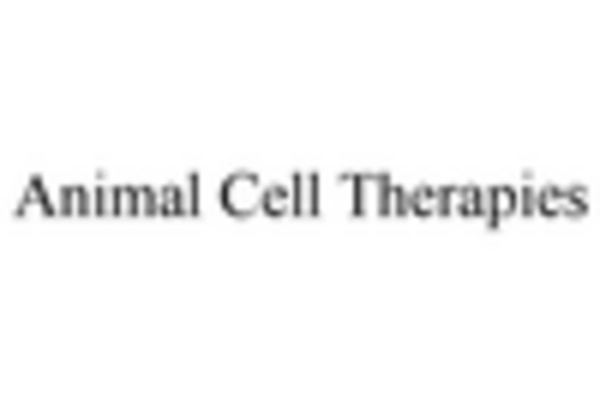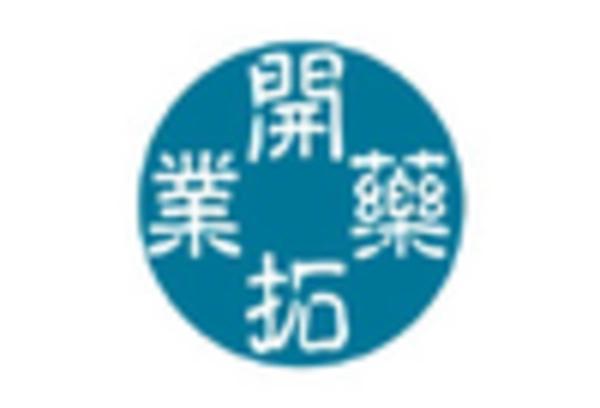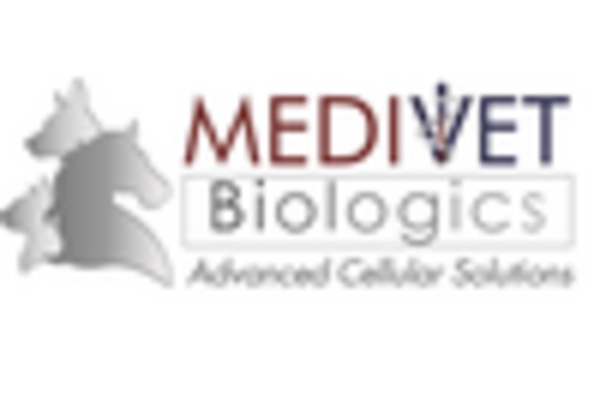The Animal Stem Cell Therapy Market is currently characterized by a dynamic competitive landscape, driven by increasing demand for innovative veterinary treatments and advancements in regenerative medicine. Key players such as VetStem Inc. (US), MediVet Biologics (AU), and Aratana Therapeutics (US) are strategically positioning themselves through a combination of research and development, partnerships, and regional expansions. VetStem Inc. (US) focuses on pioneering stem cell therapies for various animal species, while MediVet Biologics (AU) emphasizes the development of biologics for companion animals. Aratana Therapeutics (US) is leveraging its expertise in animal health to introduce novel therapies, thereby enhancing its competitive edge. Collectively, these strategies contribute to a robust competitive environment, fostering innovation and collaboration within the market.
In terms of business tactics, companies are increasingly localizing manufacturing and optimizing supply chains to enhance efficiency and reduce costs. The market appears moderately fragmented, with several players vying for market share. This fragmentation allows for diverse approaches to product development and marketing, as companies seek to differentiate themselves through unique offerings and targeted strategies. The collective influence of these key players shapes the market structure, driving competition and encouraging continuous improvement in therapeutic options.
In August 2025, VetStem Inc. (US) announced a strategic partnership with a leading veterinary hospital network to expand its reach and enhance the accessibility of its stem cell therapies. This collaboration is expected to facilitate the integration of VetStem's innovative treatments into routine veterinary care, potentially increasing patient outcomes and driving revenue growth. The partnership underscores the importance of accessibility in the competitive landscape, as companies strive to make advanced therapies available to a broader audience.
In September 2025, MediVet Biologics (AU) launched a new line of stem cell products specifically designed for equine applications. This product line aims to address the growing demand for regenerative therapies in the equine sector, which has seen a surge in interest from horse owners and trainers. By diversifying its product offerings, MediVet Biologics (AU) positions itself to capture a larger share of the equine market, reflecting a strategic move to capitalize on niche segments within the broader animal health industry.
In October 2025, Aratana Therapeutics (US) received regulatory approval for a novel stem cell therapy targeting osteoarthritis in dogs. This approval marks a significant milestone for the company, as it not only validates its research efforts but also enhances its product portfolio. The introduction of this therapy is likely to strengthen Aratana's market position, as it addresses a prevalent condition affecting a large population of dogs, thereby appealing to pet owners seeking effective treatment options.
As of October 2025, the Animal Stem Cell Therapy Market is witnessing trends such as digitalization, sustainability, and the integration of artificial intelligence in research and development processes. Strategic alliances are increasingly shaping the competitive landscape, enabling companies to pool resources and expertise to accelerate innovation. Looking ahead, competitive differentiation is expected to evolve, with a shift from price-based competition to a focus on technological advancements, innovative therapies, and reliable supply chains. This transition may redefine how companies position themselves in the market, emphasizing the importance of quality and efficacy in therapeutic offerings.

















Leave a Comment